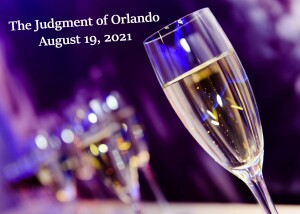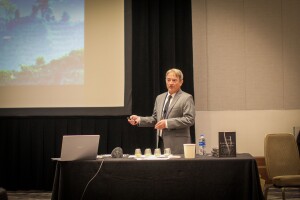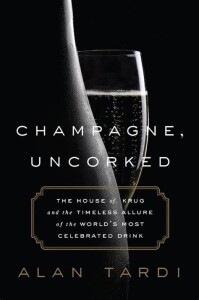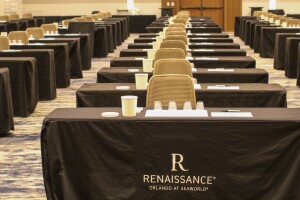Today we offer a recap of a session—The Judgment of Orlando—from the 45th Conference of the Society of Wine Educators, written by session presenter Alan Tardi
I recently had the pleasure of conducting a session at the Society of Wine Educators 45th Annual Conference, live and in person after a 2-year hiatus due to the pandemic. While I am always pleased to be invited to present at conference, this time I felt a bit jealous of the participants sitting in the ballroom.
Each person had their own well-spaced table, and on the table were 12 exceptional sparkling wines. Of course, I had 12 wines in front of me too, but I was standing up talking rather than sitting down tasting and, unlike the audience, I already knew what the wines where!
All of them—with one exception—were made using the Méthode Champenoise, known as the Traditional Method anywhere outside of Champagne. And, while I gave a brief discourse on the origin and evolution of sparkling wine, the audience embarked on a sort of treasure hunt, tasting through the wines in front of them, without having been given any indication of what they were.
Then we addressed each of the wines one by one: Is this wine Champagne or is it not Champagne? If it is not Champagne, is it from the Old World or New? More importantly, why? And what are these impressions and deductions based on?
There were 4 Champagnes, 4 Old World sparklers and 4 New World, but none of the participants knew this and the tasting order was intentionally mixed up. All the wines were carefully selected and of extremely high caliber, and each of them was unique yet very representative of its specific place of origin.
From Champagne, there were two classic Maison and two grower-producers. Pierre Gerbais‘ “L’Originale” from the southern department of the Aube, was made from 100% Pinot Blanc (aka Vrai Blanc) from a vineyard planted in 1904, while Aurelien Laherte‘s “Les 7” was comprised of all seven permitted grape varieties of Champagne made from a base wine that came from a perpetual reserve started in 2003.
The 167th edition of Krug’s “Grande Cuvée” (base year 2011) was a masterful assemblage of the three principal grape varieties of Champagne consisting of 191 different wines, including a healthy amount of reserve wines going back to 1995. The iconic “Clos des Goisses” 2005 of Philipponnat (which traces its winegrowing origins back to 1522), was comprised of Pinot Noir and Chardonnay from within the steep enclosed vineyard, a wine that many believe constitutes the first site-specific bottling of Champagne.
Other Old-World wines included the “Classic Cuvée” (base year 2011) from Nyetimber, located in Southern England in an area that is, geologically speaking, an extension of the chalky Paris Basin which plays a huge role in the northern Champagne growing area of the Marne. From Trentino in northern Italy, we had a 100% Chardonnay from a single vineyard about 600 meters above sea level that spent 8 years on the lees. This special bottling, made only in exceptional vintages, is named after the founder of the winery (1902) who went to Champagne, fell in love (with the wine), and was compelled to make a champagne-style wine in his homeland, laying the foundation for what is now known as Trento DOC.
Something similar happened a century earlier when a member of the Raventós family—which traces its winegrowing activity in the Penedès area of Catalonia to 1497—returned home from Champagne in 1872 determined to make a sparkling wine using the Champagne method but with the native grape varieties of his region. It was a big success; many others in the area started to make it and Cava was born. Ironically, Raventós decided to withdraw from the Cava DO in 2012 because they felt that the integrity of the appellation they essentially created had been severely compromised. The wine we tasted was made of 100% Xarel.lo grapes personally selected by Josep Maria Raventós i Negra from the 2005 vintage which spent about 6 years on the lees.
There was also another wine from Italy, a sort of red herring in the form of a Prosecco DOCG made from very old vines in Valdobbiadene by Paolo Bisol of Ruggeri winery. What made it very unusual was that this wine spent four years in an autoclave on the lees (plus one year in bottle) which gave it some subtle autolytic hints resonant of something one might find in a vintage champagne. [This was an experiment; only 4500 bottles were made, they’re practically gone now and bottles for this event had to be sent from Italy.]
New World selections consisted of four prestige-level wines: “Cuvée Clive”, a Cap Classique from Graham Beck Estate, South Africa; Schramsberg “Reserve”, from one of California’s oldest non-mission wineries (founded 1862) that was re-born as sparkling specialist by the Davies family in 1965; “Le Reve” from Domaine Carneros, a winery started by Claude Taittinger in 1987; and “L’Hermitage” from Roederer Estate (founded 1982), offshoot of another highly respected and well-established maison of Champagne.
With 12 exceptional wines to taste, deduce, critique and explore, we didn’t have time to go into great detail or compare peoples’ contrasting impressions of the wines. And, unlike the 1974 “Judgment of Paris” tasting organized by Steven Spurrier (RIP) in which cabernet sauvignon-based wines from California won out over Bordeaux in a blind tasting, there was no clear consensus in Orlando and participants were quite divided (or ambiguous) about whether a wine was Champagne or not, or whether it was Old World or New.
But that was perfectly fine. The structure of this presentation was not intended so much as a contest to determine the ‘best’ but rather as an opportunity sharpen our faculties of taste, make some deductions about what we tasted, and explore the impact of provenance and production method unhindered by prejudice — not to mention have fun and taste some great wines together, in person!
I do hope participants found it enjoyable and insightful.
P.S. If you weren’t able to be there, you might like to pick a few bottles and create your own ‘judgment’ tasting! Click here for a Wine List-Judgment of Orlando as presented by Alan Tardi
–Alan Tardi
You might also like to pick up a copy of my book “Champagne, Uncorked.” I’m offering SWE members a 25% discount off cover price (plus cost of shipping) and would be happy to sign it if you wish. Write to me at alantardi@aol.com and I will send you an order form. Click here for more information about the SWE Discount for Champagne Uncorked by Alan Tardi




I attended the conference and enjoyed this seminar. I liked that we were able to taste and write our notes before we knew what the wines were. Very interesting and well done. Thank you